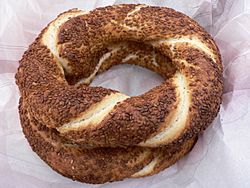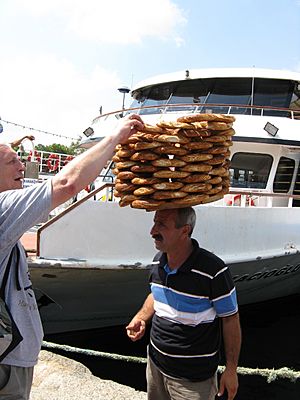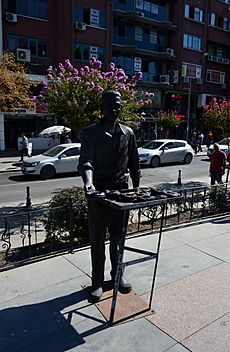Simit facts for kids
 |
|
| Alternative names | bokegh (Armenia), Đevrek (Bosnia, Serbia), koulouri (Greece), covrig (Romania), gevrek (Bulgaria), Turkish bagel (United States) |
|---|---|
| Type | Bread |
| Place of origin | Ottoman Empire |
| Main ingredients | Dough (flour, water, yeast, salt), sesame seeds |
| Variations | also called Shureik, Ka'ak, and Sameet |
Simit is a delicious, round bread. It is usually covered with sesame seeds. Sometimes, you might find it with poppy, flax, or sunflower seeds instead. This popular bread is found in many countries that were once part of the Ottoman Empire, and across the Middle East.
The size, crunch, and chewiness of simit can be a little different depending on where you are. In the United States, people often call it a "Turkish bagel." In the city of İzmir, it's known as gevrek, which means "crisp." Simit from Ankara are usually smaller and crunchier than those from other cities.
Contents
What's in a Name?
The name simit comes from the Arabic word samīd. This word means "white bread" or "fine flour."
Other names for this bread come from old Greek words. For example, in modern Greek, it's called koulouri. In Aramaic, it's qeluro or qelora. In Turkish, it can also be called gevrek. Many South Slavic languages use names like đevrek. The Armenian name is bokegh. In Judaeo-Spanish, it's known as roskas turkas.
Where Did Simit Come From?
Simit has a long history! Records show that this bread has been made in Istanbul since 1525. In 1593, rules were set for how much simit should weigh and how much it should cost.
A traveler named Evliya Çelebi wrote that there were 70 simit bakeries in Istanbul in the 1630s. Paintings from the early 1800s show simit sellers on the streets of Istanbul. An artist named Warwick Goble also drew these sellers in 1906. Over time, simit became popular all across the Ottoman Empire.
How People Enjoy Simit


People often eat simit plain. It's also a popular choice for breakfast with tea, fruit preserves, or cheese. Drinking tea with simit is a common tradition in Turkey. In Armenia, simit (called "Bokegh") is a traditional Christmas bread.
You can often buy simit from street vendors in Turkey. They might have a special trolley or carry the simit on a tray on their head. These sellers often call out that their simit is fresh ("Taze simit!") or hot ("Sıcak, sıcak!"). If it's very hot, they might even say "El yakıyor!" which means "It burns the hand!"
Simit is an important food for many people in Turkey. Sometimes, it's even called susam kebabı, which means "sesame kebab." In other parts of the Middle East, people eat it with boiled eggs or a spice mix called duggah. In mosques in Mecca and Medina, it's often eaten to break the fast, along with yogurt or buttermilk.
Today, many cities in Turkey have their own companies that make simit.
Breads Similar to Simit
There are other breads around the world that are like simit:
- Some types of Romanian covrigi are very similar. Places that sell them are even called "Simigerii."
- In Poland, there's a bread called obwarzanek krakowski. In Russia, Ukraine, and Belarus, it's called bublik. The main difference is that these breads are briefly boiled in water before baking, like a bagel. Simit is dipped in water and molasses syrup instead.
- Girde is a bread from the Uyghurs in China. It's baked on the walls of a special oven called a tandoori. It looks very much like simit and is a key part of Uyghur cooking.
Images for kids
See also
 In Spanish: Simit para niños
In Spanish: Simit para niños






